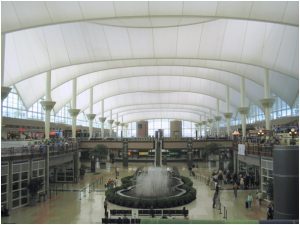Architects creating fabric structures in the 21st century have a wide variety of materials from which to choose for both external and internal projects. Such choice allows for extensive freedom of form across a variety of functions and has led to the development of striking and iconic buildings across the world.

Teflon-Coated Fibreglass (PTFE)
Also known as coated fabric, this strong, dimensionally stable material’s heat-resisting properties, combined with a lifespan of around twenty years, have made it a popular product for a wide range of tensile structures.
Silicone-Coated Fibreglass (SiPE)
SIPE is a popular alternative to PTFE, having many of the qualities of PTFE at a lower cost. Strong, flexible and fire-resistant, SIPE can be manufactured in a range of colours and translucence, making it an attractive choice.
Woven PTFE (ePTFE)
Together with excellent resistance to water and light, the high-strength PTFE involved in manufacture helps make Woven PTFE a versatile and durable product. Amongst the benefits of this fabric are those of being able to be folded and flexed repeatedly, making it an excellent choice for structures that have retractable elements, such as the sporting venue projects of http://fabricarchitecture.com/.
High-Density Polyethylene (HDPE)
One of the most popular plastics in use around the world, HDPE is ideal for shading in agricultural applications. This shade mesh material is not waterproof but provides Class A fire resistance and is manufactured in a wide variety of colours and styles. With a lifespan of around 10 years, HDPE is a popular choice in hot and dry climates with its excellent UV stability and absorption.
Ethylene Tetrafluoroethylene (ETFE)
In contrast to other fabric architecture materials, ETFE is a transparent film, most typically utilised in layers of pneumatic pillows which are kept under pressure to maintain stability and provide some insulation if utilised as an alternative to glass in roofing solutions.
Vinyl-Coated Polyester (PVC)
PVC has long been widely used and is inexpensive, pliable and able to withstand a wide temperature range with minimal stretching. With a lifespan of around 25 years, PVC is used extensively in both temporary and permanent structures. It is available in a variety of types and is top-coated to be resistant to staining and discolouration.
Use of these proven flexible materials is delivering a wide variety of functional, innovative and memorable fabric architecture.
